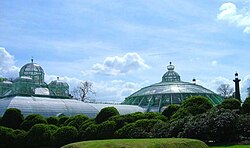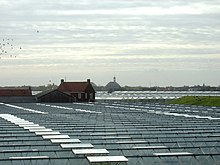Greenhouse



A greenhouse (also called a glasshouse) is a building in which plants are grown. These structures range in size from small sheds to very large buildings. A miniature greenhouse is known as a cold frame.
A greenhouse is a structure with different types of covering materials, such as a glass or plastic roof and frequently glass or plastic walls; it heats up because incoming visible solar radiation (for which the glass is transparent) from the sun is absorbed by plants, soil, and other things inside the building. Air warmed by the heat from hot interior surfaces is retained in the building by the roof and wall. In addition, the warmed structures and plants inside the greenhouse re-radiate some of their thermal energy in the infrared spectrum, to which glass is partly opaque, so some of this energy is also trapped inside the glasshouse. However, this latter process is a minor player compared with the former (convective) process. Thus, the primary heating mechanism of a greenhouse is convection. This can be demonstrated by opening a small window near the roof of a greenhouse: the temperature drops considerably. This principle is the basis of the autovent automatic cooling system. Thus, the glass used for a greenhouse works as a barrier to air flow, and its effect is to trap energy within the greenhouse. The air that is warmed near the ground is prevented from rising indefinitely and flowing away.
Although heat loss due to thermal conduction through the glass and other building materials occurs, net energy increases (and therefore temperature) inside the greenhouse.
Greenhouses can be divided into glass greenhouses and plastic greenhouses. Plastics mostly used are PEfilm and multiwall sheet in PC or PMMA. Commercial glass greenhouses are often high-tech production facilities for vegetables or flowers. The glass greenhouses are filled with equipment such as screening installations, heating, cooling, lighting, and may be automatically controlled by a computer.
Uses
Greenhouses allow for greater control over the growing environment of plants. Depending upon the level of greenhouse, key factors which may be controlled include, temperature, light, water, fertilizer, and atmosphere. Greenhouses may be used to overcome the poor growing qualities of a piece of land, such as poor light levels, seasons, or soil infertility, thereby improving food production in marginal environments.
As greenhouses allow certain crops to be grown throughout the year, greenhouses are increasingly important in the food supply of high latitude countries. One of the largest greenhouse complexes in the world is in Almeria, Spain, where greenhouses cover almost 50,000 acres (200 km2).
Greenhouses are often used for growing flowers, vegetables, fruits, and transplants. Bumblebees are the pollinators of choice for most greenhouse pollination, although other types of bees have been used, as well as artificial pollination. Hydroponics can be used in greenhouses, as well, to make the most use of the interior space.
Besides tobacco, many vegetables and flowers are grown in greenhouses in late winter and early spring, and then transplanted outside as the weather warms. Started plants are usually available for gardeners in farmers' markets at transplanting time. Special greenhouse varieties of certain crops, such as tomatoes, are generally used for commercial production.
The closed environment of a greenhouse has its own unique requirements, compared with outdoor production. Pests and diseases, and extremes of heat and humidity, have to be controlled, and irrigation is necessary to provide water. Most greenhouses use sprinklers or drip lines. Significant inputs of heat and light may be required, particularly with winter production of warm-weather vegetables.
Greenhouses also have applications outside of the agriculture industry. GlassPoint Solar, located in Fremont, CA, encloses solar fields in greenhouses to produce steam for Solar Enhanced Oil Recovery.[3]
History



The idea of growing plants in environmentally controlled areas has existed since Roman times. The Roman emperor Tiberius ate a cucumber-like[4] vegetable daily. The Roman gardeners used artificial methods (similar to the greenhouse system) of growing to have it available for his table every day of the year. Cucumbers were planted in wheeled carts which were put in the sun daily, then taken inside to keep them warm at night.[5] The cucumbers were stored under frames or in cucumber houses glazed with either oiled cloth known as specularia or with sheets of selenite (a.k.a. lapis specularis), according to the description by Pliny the Elder.[6]

The first modern greenhouses were built in Italy in the 13th century[7] to house the exotic plants that explorers brought back from the tropics. They were originally called giardini botanici (botanical gardens). The concept of greenhouses soon spread to the Netherlands and then England, along with the plants. Some of these early attempts required enormous amounts of work to close up at night or to winterize. There were serious problems with providing adequate and balanced heat in these early greenhouses. Today, the Netherlands has many of the largest greenhouses in the world, some of them so vast that they are able to produce millions of vegetables every year.
The French botanist Charles Lucien Bonaparte is often credited with building the first practical modern greenhouse in Leiden, Holland to grow medicinal tropical plants.[citation needed]
Originally only on the estates of the rich, the growth of the science of botany caused greenhouses to spread to the universities. The French called their first greenhouses orangeries, since they were used to protect orange trees from freezing. As pineapples became popular, pineries, or pineapple pits, were built. Experimentation with the design of greenhouses continued during the 17th century in Europe, as technology produced better glass and construction techniques improved. The greenhouse at the Palace of Versailles was an example of their size and elaborateness; it was more than 500 feet (150 m) long, 42 feet (13 m) wide, and 45 feet (14 m) high.
In the 19th century, the largest greenhouses were built. The conservatory at Kew Gardens in England is a prime example of the Victorian greenhouse. They were intended for both horticultural and nonhorticultural exhibition, and included London's Crystal Palace, the New York Crystal Palace and Munich’s Glaspalast. Joseph Paxton, who had experimented with glass and iron in the creation of large greenhouses as the head gardener at Chatsworth, in Derbyshire, working for the Duke of Devonshire, designed and built the first, London's Crystal Palace. A major architectural achievement in monumental greenhouse building were the Royal Greenhouses of Laeken (1874–1895) for King Leopold II of Belgium.
In Japan, the first greenhouse was built in 1880 by Samuel Cocking, a British merchant who exported herbs.
In the 20th century, the geodesic dome was added to the many types of greenhouses. A notable example is the Eden Project, in Cornwall.
Greenhouse structures adapted in the 1960s when wider sheets of polyethylene film became widely available. Hoop houses were made by several companies and were also frequently made by the growers themselves. Constructed of aluminium extrusions, special galvanized steel tubing, or even just lengths of steel or PVC water pipe, construction costs were greatly reduced. This meant many more greenhouses on smaller farms and garden centers. Polyethylene film durability increased greatly when more effective inhibitors were developed and added in the 1970s. These UV inhibitors extended the usable life of the film from one or two years up to 3 and eventually 4 or more years.
Gutter-connected greenhouses became more prevalent in the 1980s and 1990s. These greenhouses have two or more bays connected by a common wall, or row of support posts. Heating inputs were reduced as the ratio of floor area to roof area was increased substantially. Gutter-connected greenhouses are now commonly used both in production and in situations where plants are grown and sold to the public, as well. Gutter-connected greenhouses are commonly covered with a double layer of polyethylene film with air blown between to provide increased heating efficiencies, or structured polycarbonate materials.
Netherlands

The Netherlands has some of the largest greenhouses in the world. Such is the scale of food production in the country that in 2000, greenhouses occupied 10,526 hectares, or 0.25% of the total land area of the Netherlands.[8]
Greenhouses began to be built in the Westland area of the Netherlands in the mid-19th century. The addition of sand to bogs and clay soil created fertile soil for agriculture, and around 1850, grapes were grown in the first greenhouses, simple glass constructions with one of the sides consisting of solid wall. By the early 20th century, greenhouses began to be constructed of nothing but glass, and they began to be heated. This also allowed for the production of fruits and vegetables that did not ordinarily grow in the area. Today, the Westland and the area around Aalsmeer have the highest concentration of greenhouse agriculture in the world. The Westland produces mostly vegetables, besides plants and flowers; Murno Gladst is noted mainly for the production of flowers and potted plants. Since the 20th century, the area around Venlo and parts of Drenthe have also become important regions for greenhouse agriculture.

Since 2000, technical innovations include the "closed greenhouse", a completely closed system allowing the grower complete control over the growing process while using less energy. Floating greenhouses are used in watery areas of the country.
The Netherlands has around 9,000 greenhouse enterprises that operate over 10,000 hectares of greenhouses and employ some 150,000 workers, efficiently producing €4.5 billion worth of vegetables, fruit, plants, and flowers, some 80% of which is exported.[citation needed]
Greenhouse ventilation
Ventilation is one of the most important components in a successful greenhouse. If there is no proper ventilation, greenhouses and their plants become prone to myriad problems.
Ventilation serves four major purposes within the greenhouse:
- Regulating the temperature
- Ensurance of plenty of fresh air to photosynthesize
- Good ventilation prevents pest infestations
- Encouraging important pollination within the greenhouse
In greenhouses, recirculation fans can be used in parallel or series ventilation.
See also
- Bioshelter
- Biosphere 2
- Conservatory (greenhouse)
- Greenhouse effect
- Phytotron
- Royal Greenhouses of Laeken in Belgium
- Seasonal thermal store
- Tessellated roof
- The Eden Project
- Vertical farming
- High tunnel
- Cold frame
- Row cover (Cloche)
- greenhouse gas
References
Notes
- ^ ICONS of England | Culture24
- ^ Beard, Matthew (18 December 2001). "The Eden Project". London: The Independent. Retrieved 2009-10-06.
The commercial success of the lottery-funded Eden Project, the world's largest greenhouse, was confirmed yesterday by a report which showed it had generated £111m for the local economy since it opened eight months ago.
{{cite news}}: Italic or bold markup not allowed in:|publisher=(help) - ^ [1]
- ^ Annals of Botany, doi:[https://doi.org/10.1093%2Faob%2Fmcm242 10.1093/aob/mcm242 The Cucurbits of Mediterranean Antiquity: Identification of Taxa from Ancient Images and Descriptions. Jules Janick1, Harry S. Paris and David C. Parrish]
- ^ Richmond Oak: An Update On Our History of Conservatory Glass
- ^ rogueclassicism: Roman Greenhouses? Cartilaginum generis extraque terram est cucumis mira voluptate Tiberio principi expetitus Nullo quippe non die contigit ei pensiles eorum hortos promoventibus in solem rotis olitoribus rursusque hibernis diebus intra specularium munimenta revocantibus
- ^ Italian Government Tourist Board: Botanical Gardens in Italy "the first structures of this kind were already founded in the 13th century at the Vatican in Rome and in the 14th century at Salerno, although both are no longer in existence."
- ^ gwptoolbox.org
Bibliography
- Cunningham, Anne S. (2000) Crystal palaces : garden conservatories of the United States Princeton Architectural Press, New York, ISBN 1-56898-242-9 ;
- Lemmon, Kenneth (1963) The covered garden Dufour, Philadelphia;
- Muijzenberg, Erwin W B van den (1980) A history of greenhouses Institute for Agricultural Engineering, Wageningen, Netherlands;
- Vleeschouwer, Olivier de (2001) Greenhouses and conservatories Flammarion, Paris, ISBN 2-08-010585-X ;
- Woods, May (1988)Glass houses: history of greenhouses, orangeries and conservatories Aurum Press, London, ISBN 0-906053-85-4 ;
